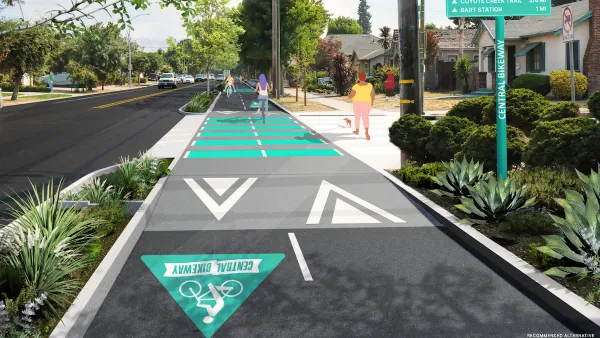The Federal Highway Administration (FHWA) on May 18 announced new guidelines for the planning and design of separated bike lanes.

Greg Nadeau, acting administrator of the FHWA, writes a post announcing the release of the Separated Bike Lane Planning and Design Guide, which, among other things, explains the importance of separated bike lanes to a multi-modal transportation system: These lanes are an important tool communities across the U.S. can use to build safe, comfortable, and connected networks of bicycle infrastructure that meet the needs of people of all ages and abilities."
In addition to a number of case studies, "FHWA’s guide outlines planning considerations and design options for this innovative bicycle facility. It provides information on one and two-way facilities, outlines different options for providing separation, and highlights midblock design considerations including driveways, transit stops, accessibility, and loading zones. Intersection design is also taken into consideration, including the related operations, signalization, signage, and on-road marking concerns."
Nadeau mentions that the new Guide is intended to support the U.S. DOT's Safer People, Safer Streets initiative.
FULL STORY: FHWA introduces Separated Bike Lane Planning and Design Guide

Planetizen Federal Action Tracker
A weekly monitor of how Trump’s orders and actions are impacting planners and planning in America.

Chicago’s Ghost Rails
Just beneath the surface of the modern city lie the remnants of its expansive early 20th-century streetcar system.

Amtrak Cutting Jobs, Funding to High-Speed Rail
The agency plans to cut 10 percent of its workforce and has confirmed it will not fund new high-speed rail projects.

Ohio Forces Data Centers to Prepay for Power
Utilities are calling on states to hold data center operators responsible for new energy demands to prevent leaving consumers on the hook for their bills.

MARTA CEO Steps Down Amid Citizenship Concerns
MARTA’s board announced Thursday that its chief, who is from Canada, is resigning due to questions about his immigration status.

Silicon Valley ‘Bike Superhighway’ Awarded $14M State Grant
A Caltrans grant brings the 10-mile Central Bikeway project connecting Santa Clara and East San Jose closer to fruition.
Urban Design for Planners 1: Software Tools
This six-course series explores essential urban design concepts using open source software and equips planners with the tools they need to participate fully in the urban design process.
Planning for Universal Design
Learn the tools for implementing Universal Design in planning regulations.
Caltrans
City of Fort Worth
Mpact (founded as Rail~Volution)
City of Camden Redevelopment Agency
City of Astoria
City of Portland
City of Laramie





























